#marsupial dwarves
Text
Biology of Fortress Dwarves
So I've been playing a lot of dwarf fortress lately, and one thing I've noticed is that dwarves are weird. So naturally I've spent a lot of time thinking about how their biology might work and I've come to the conclusion that the dwarves in dwarf fortress are marsupials. Hear me out, I promise it will make sense.
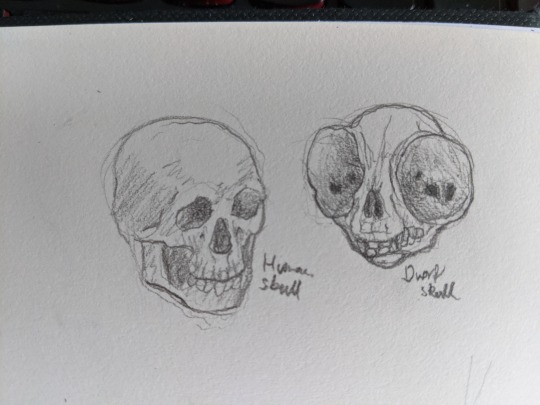
Large eyes explain many dwarfisms
Dwarf basics
Dwarves are short humanoid creatures that dig holes and build fortresses. They don't need light underground and get cave adapted if they don't get exposed to sunlight often, making them dizzy and confused when they do encounter it. To see in near darkness they would have massive eyes, and for navigating in total darkness long whiskers. The consequences of having huge eyes would explain two other facts about dwarves, namely the fragility of their skulls and their incredible talent for stupidity. No space for brain or bone in their head, it's all eyes.
They will eat just about anything except other dwarves but they don't need to eat often, something that caused me to initially assume they might actually be a form of reptile but is better explained simply by them having a lower body temperature and therefore slower metabolism than a typical mammal. None of this is strong evidence for any particular theory so let's move on.

Urist McCaveAdapted
Dwarf reproduction
Married heterosexual dwarf couples can have babies. Lots of babies. Dwarf women can have aproximately one baby a year, thanks to their short gestation period and the fact that they can become pregnant again immediately after birth. Pregnant dwarves show no outward signs of being pregnant, and birth happens while the mother is about doing her job - which will be interupted as she then looks for the child. Now the main advantage of the marsupial pouch is precisely that, allowing young to be born early reducing the risk to the mother from the birthing process and allowing the mother to get pregnant again sooner. Marsupials are born tiny and able to crawl, so it would make sense that the first thing they need to do after giving birth is find the baby and make sure it makes it into the pouch.
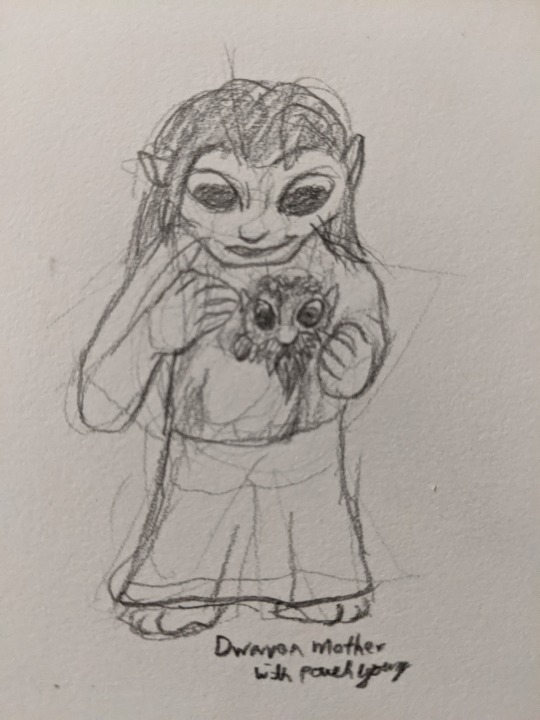
A dwarf mother in a rare moment of remembering her baby exists
Dwarven childcare
Dwarves are babies for one year, during which time their mothers never put them down (unless they are washed down a drain or other misadventure). The mother is able to act normally while carrying her baby, even doing things like fighting or tasks that require both hands. So she must be carrying the baby in some other way, and a marsupial pouch would be ideal for the task. Even the issue of chest deep water causing mothers to loose their offspring makes sense for marsupial dwarves, as one of the limitations of the marsupial pouch is the fact that pouch young are vulnerable to being washed out of the pouch if the adult is in water.
It even explains the lack of beards on dwarf women, as they would get in the way of the baby climbing into the pouch.
Marsupial dwarves. You're welcome.
Like my work? Support me on Patreon
#dwarf fortress#dorf fort#df#strike the earth#dwarf#speculative biology#my art#dwarffortress#marsupial dwarves
253 notes
·
View notes
Text
Little Known Biology Facts About D&D Species
Humans: Humans don't exist. The concept comes from misidentified sightings of weasels who have been given adorable people clothes for the purpose of Facebook photos.
Dwarves: Unlike other species who have long lifespans due to divine blessings, Dwarves don't age because their genomes aren't fucking quitters.
Elves: Elves are marsupials. Other species don't notice because instead of storing their young, their pouches are used to store the excess smugness they couldn't fit in their central nervous system.
Goblins/Gnomes: This is actually a single species with extreme sexual dimorphism. If you're wondering which sex is goblins and which is gnomes? Don't worry, so are they.
Halflings: Halflings physically require tea and biscuits once a week or their hair dyes itself edgy colors and they grasp the concept of dubstep. Only large amounts of Enid Blyton books and crumpets can reverse this transformation.
Dragons: Dragons are actually only 15 inches long at full adulthood. It's just that like many lizards they puff up when threatened and you're adventurers so you only meet them when threatening them.
Orcs: In an act often misidentified as raiding, Orcs are the ones putting people clothes on the weasels and sharing the images on facebook. It's part of how they achieve homeostasis.
Kobolds: Basically what they look like TBH. They're funky little lizard guys, what more do you want?
3K notes
·
View notes
Text

Dwarves are folk found in the mountains of the world. Their underground warrens are a twisted complex of communal tunnels and caverns. They are eusocial genderless marsupials that use stonecrafting magic to create weapons, tools and structures. Their diet mostly consists of bugs, tubers and ale.
Elves are folk found in the forests of the world. Their wooden hives are both carefully considered and aesthetically beautiful. They are eusocial genderless insects that use woodcrafting magic to create weapons, tools and structures. Their diet mostly consists of fruit, leaves and nectar.
Here's the basic bodyplans of both dwarves and elves, these are subject to change. Not all elves grow floral clothes.
#creature design#art#fantasy art#character design#fantasy#monster art#monster design#xenobiology#speculative biology#speculative zoology#species design#elf#dwarf#ollyneanderthal art
259 notes
·
View notes
Text
Various degrees of cuisine hot takes:
Elves are carnivores
dwarves eat lots of minerals but are not opposed to the occasional insect or mushroom
orcs are omnivores with a robust farming culture in their homeland
forest trolls are fruitarian and require a high sugar intake to stay active - animal protein is toxic to them and can cause them to go into a manic delirium often perceived as a “rage” after which they enter a torpor state.
Ogres eat dirt and worms n roots and stuff while they use their strong jaws to burrow into the earth.
smaller goblin species evolved from scavengers and carrion eaters, so modern goblins in a mixed societal setting have a tolerance of most culture’s cuisine
larger goblin species - the various hob goblins and bugbears - are omnivorous and fall somewhere between humans and small goblins in their foods
gnomes are insectivores with a side of berries/mushrooms depending on the subspecies
halfings eat seeds, berries and insects
Unrelated to foods but both Gnoll and Centaur are marsupials
11 notes
·
View notes
Text
So, there’s a good number of you who did not grow up in the Dwarven systems. Dwarves generally don’t end up across the galaxy- we don’t travel much. If you’re here, it’s probably because you were born in some penal or mining colony nearby and never really moved far. Similar to my own life, actually.
So, you would be forgiven for not knowing that on Dwarven planets, the food chains do not, in fact, end in Dwarf. We have a natural predator.
They’re called Minterrels. I’ve never actually seen one, but I’ve seen their bodies. They’re gigantic, easily the size of Deep Rock’s Space Rigs. They’re cave-dwelling, with one of the most uncomfortable metamorphic progressions of any creature I’ve ever heard of. They start out as rodent-marsupials; sort of similar to that rodent from my last post, actually. They’re a bit smaller then, only the size of our Refinery Rigs or so. They’re padded and furred and they just skitter around gnawing their way through stone. But they’re completely silent, and they love eating Dwarf. After centuries of chewing on cold, hard, occasionally slimy stone and crystal, a morsel of soft, warm flesh is like a banquet to them. It’s also the only way they actually get the proteins they need to stimulate their metamorphosis, even though they can survive on silicate compounds.
After they cocoon and pop out, they’ve grown a few more limbs and their bodies have lengthened out. Adult Minterrels are classified as felines. Now, the issue with this is that they can ONLY get their nutrients from Dwarf.
Regardless of maturity, they’re got the fur, the big eyes, and a few other choice characteristics. These characteristics stimulate adoration in pretty much anyone who looks at them, but every single one has an evolutionary hunting purpose. The eyes give them an affinity for the night. The small noses allow them to selectively follow certain scents. The fur and pads ensure that they are silent, traceless ambush predators. And in Dwarven history, possible millions of Dwarves have died trying to pet what they thought was a cute, tame animal, because Minterrels can mimic domesticity. They’re seriously evil. Dwarven hearthworlds have whole divisions of soldiers dedicated to killing Minterrels, and you usually need at least a hundred heavily armed Dwarves to take one down.
But, y’know, forget our evolutionary fears because they’re cute looking, right?
34 notes
·
View notes
Note
Okok I'm back to ask another question just because. (Hi I'm the anon asking about bat goblins! Though, unrelated to this ask, kind of)
Are your amphibious goblins, perhaps, related to grung in some capacity? Do you even have grung in your world?
Sorry, it just popped in my mind! Hope it's not too much of a bother to answer my asks, but since I asked for help, I might as well ask for you to talk about your world for fun! :)
i hadn't actually known about the grung before i read through this lol. they look adorable. poison dart frogs have such fun colors and make an interesting base for a people species.
My world building is already full of like. uhhhh 3 sylvanids, 3 orciformes.... goblins, dwarves, pixies, centaurs, ogres, kobolds (2 varieties) merfolk (various?) quetzalin, and i had a concept for marsupial satyrs (2 varieties) i think.. i think that's all of them. as u can see, it is. A Lot. and there are so many more that I could add! gnolls! bat people! minotaurs! but for the sake of keeping my world building from getting too messy, i kinda. have to delegate which species are actually relevant to the plot. where they all originate from, how many of them have actually spread around the world and which ones are more localized, etc.
a lot of my worldbuilding is just going to end up in a supplementary book where i can be like "look at all these cool details in my world that were totally irrelevant to the actual book i wanted to write!" and give people a fun sandbox to play in.
7 notes
·
View notes
Text
Elves lay eggs and dwarves much like marsupials spend their early life nestled in their father’s beard while they finish early development.
1 note
·
View note
Text
Life on Verden
Verden is a Telluric (Terra-like) planet, meaning that it has environments and life roughly similar to that of Terra. It’s not even remotely the only one, but it is one of the most well known in the Sea of Stars (Milky Way). This is largely because of it having the unique characteristic of no extant and naturally indigenous sapient species, with all resident sapients’s species being extraterrestrial. This includes humans, who were introduced because of some of the previously resident civilizations relying on slave labor and test subjects in a similar manner to Africans having been introduced to the Americas. The practice has totally stopped in the 1700′s AD/CE, but it was already thousands of years old and already heavily controversial before the 1700′s.
Verden itself is slightly smaller than Terra yet has a more oxygenated atmosphere, allowing for larger organisms with insectoid respiratory systems, or otherwise, to survive. It has many dangerous native organisms, including megafauna, especially in the oceans. It has three continents, Nordheim (the northernmost continent, hence the name), Asura (a large continent roughly the scale of Asia), and Deva (several different mainlands, the largest of which is roughly the size of South America). Its biodiversity is another reason it’s well known among the Sea of Stars. Verden has relatively smaller polar ice caps than Terra, but Nordheim is still generally cold, as is the outer part of the Southern Eye, the ocean around the south pole. It also has deserts with somewhat more biodiversity than Terran ones, most of which are in the tropical regions, and the reptilian sapients are usually found there.
Humans: The resident sapient primates and a relatively recent addition, known for their unique cultures and languages and often discriminated against in at least some form depending on the region. They are adapted to the differences in Verden’s atmosphere and though genetic experiments of the past, often have unusual physical characteristics, such as unusual hair color
Magonians: A series of closely related insectoid species of varying sizes, many species of which roughly resemble certain types of Terran insects, native to Magonia and ultimately the inspiration for the cliche modern Terran image of fae/fairies
Elves: A species of roughly cat-like semi-humanoid marsupials, known for their beauty and intelligence, native to Alfheim
Dwarves: A species of boneless and hairless semi-humanoid native to Alfheim, surprisingly strong and also having a reputation of being highly intelligent and hard-working
Dragons: There are a few resident sapient dragon species, including a semihumanoid one, a flying one, and a semiaquatic one
Dinosaurs: There are several sapient dinosaur species residing on Verden, mostly goblin (sapient dromaeosaurid) species
Aquatics: A set of distinct aquatic sapient species, including a cephalopod-like one and a few piscine-ish non-humanoid ones along with merfolk, an extraterrestrial semihumanoid aquatic species with reptilian characteristics
Verden’s human population, and to a lesser extent the other populations, have a subset of mutants collectively known as immundanes, which for humans include but are not limited to vampires, therianthropes (aka skinwalkers), and for any given immundane population, specifc lineages with unusual and often beneficial physical characteristics in general. Vampires and therianthropes here are best described as an imperfect attempt at supersoldiers, with vampires relying on nutrients usually found in mammal blood to survive (and also not any more photosensitive than mundanes, or non-immundanes) being the reason for “failure” and therianthropes, sheer physical abilities being too much for the aliens responsible for their existence.
Vampires in particular are very often found holding positions of power, high social standing, and/or are wealthy, and unlike on Terra, this is very often due to vampires having much longer lifespans than mundanes and actually working on up. For Judaism-related reasons, they and Judaists tend to not get along well, but Jewish vampires are not unheard of.
Therianthropes are often associated with warrior cultures, such as Nordic and Mesoamerican ones, but not always in a good way. The most common variants on Verden are werejaguars, werewolves, and berserkers (werebears). Berserkers in particular have a relatively bad reputation due to how they’re described in Nordic sagas, which is ironic considering that how they’re described is not necessarily portrayed as a bad thing in said sagas.
1 note
·
View note
Text
me reading that post about the Pevensie kids running Narnia and then suddenly coming back to post-war British cuisine and then I'm thinking about Prince Caspian like oh here they are in the forest and they're peeling a bear now and wrapping its nice vegetarian bearmeat (I mean the bear was a vegetarian apparently right? sigh) round apples and baking it and do they have salt though? Hmm I bet Trumpkin being a seasoned warrior hah seasoned anyway I bet he travels with salt on him oh wait, he got dunked in the estuary or whatever but no, he's Trumpkin, so surely he'd have a foolproof waterproof salt container about his person but no, when he got captured surely he got searched
and this is how I came to the conclusion that Narnian dwarves are marsupials
2 notes
·
View notes
Photo
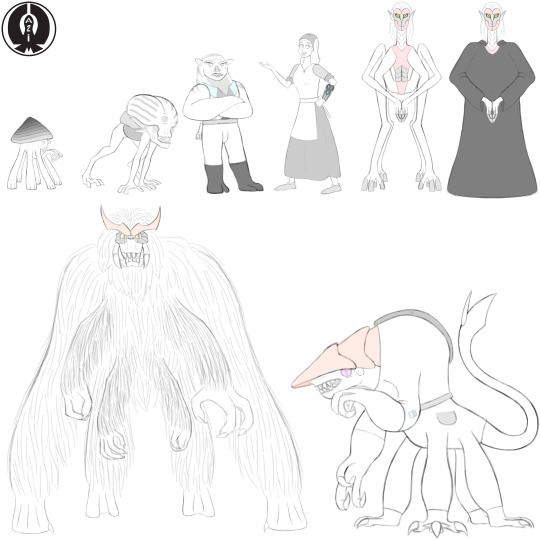
He’s another set of character sketches, this one focusing on various aliens for my Don Bluth inspired concept Galune (excluding the dragons though I should redesign them to so they don’t resemble the Grimm from RWBY too much). I included the protagonist Agatha as well to show a minor redesign and provide a sense of scale (she’s around 5′ 7″/1.7M). The theme for these aliens is that they resemble creatures from medieval European folklore. Though intended to be in the style of Don Bluth, I try to design them as creatures that could actually evolve on other worlds.
Anyway, starting with the top left I have a “gnome”; a shy, burrowing species with characteristics of mollusks and fungi. Next is a “goblin”; a frog-like species that’s clever and quick in movement and speech. The third one is an alien that appeared in a previous character set and a specific individual that’s a secondary protagonist. He is one of the “dwarves” (with fur instead of a large beard). Resembling a mix of Thylacoleos (marsupial lions) and chimpanzees, they are mechanically minded and rather strong for their size. Next is a redesign of the “elves”. The main body shape is relatively the same though I’ve moved their mouthes back to their heads and their heads “open up” in a unique way. Right below is a “troll”. Initially intended to be a redesign of the shark/squid alien from a previous character sketch set (which I called “Shaaks”, I instead made them a less aggressive species that shares a common ancestor with them. Lastly, on the bottom left, we have an “ogre”; a large, fierce species that evolved on a cold planet and has characteristics of tarantulas and orangutans.
As always comments and critiques are welcome.
#Alien#Aliens#extraterrestrial#extraterrestrials#astrobiology#Character Design#creature design#alien life#mythical creatures#my art#digital art#digital sketch#gnome#goblin#dwarf#elf#troll#ogre#concept art#Concept Design#mollusks#fungi#frog#thylacoleo#marsupial lion#shark#squid#spider#tarantula#orangutan
6 notes
·
View notes
Text
Dwarven sensitivity
Dwarves in dwarf fortress are very sensitive - they have more opinions than a human on the internet and being out in the rain once is enough to permanantly traumatise them.
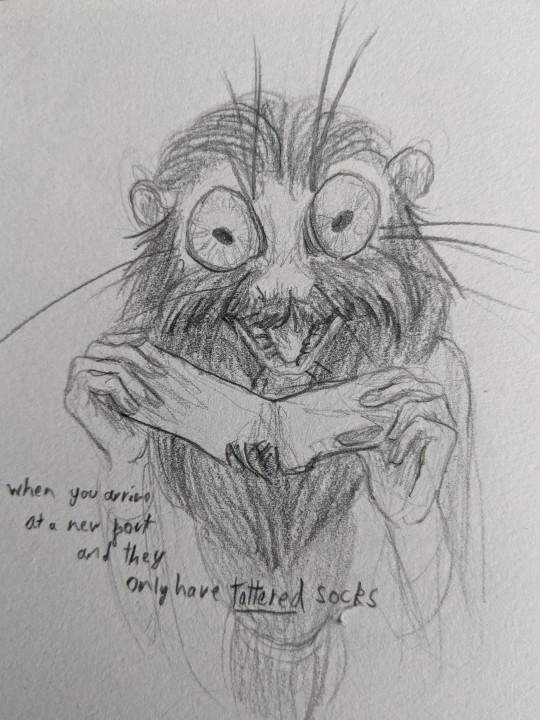
Tattered socks, a well documented cause of tantrum spirals
However, what I've actually been thinking about recently is dwarf senses, and how they navigate underground without the need for constructing lights. I'll break this into two parts because I think there are multiple factors at play and I think the answer to how they get around is different in the fort and in the mines.
The Fort
As I said earlier, dwarves have a lot of opinions about things, materials, colours, shapes and so on. This leads me to conclude they must be able to see within the fort itself, because colour is not a thing identifiable with touch. other races can find their way to dwarven taverns as well, though it would often be better for them if they did not. So if they can see there must be light, but how? I propose the existence of a symbiotic bioluminescent lichen that grows on the walls and floors of the fort, producing enough light for humans to make it to the bar and for dwarves to see across the hall that there's a statue of a slug over there and they don't like it.
But if there is something growing on the walls how does it get there? The answer is simple - on the dwarves.
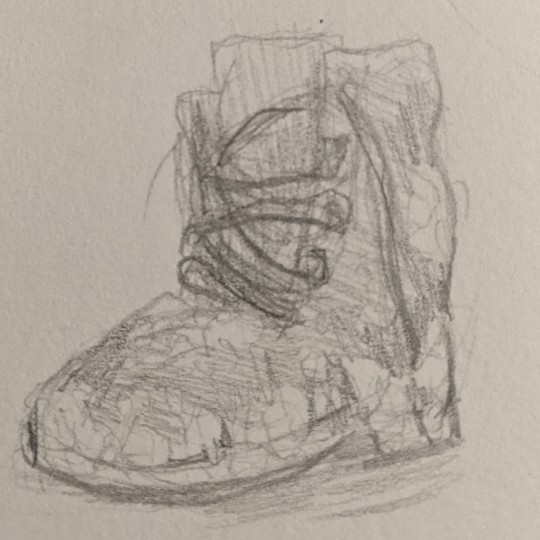
A typical dwarven high boot. It is coated in mud. It is lightly coated in Urist McDwarf's dwarf blood. It is also covered in Armok knows what else.
Migrants from other forts arrive regularly bringing new and exciting spores with them, and since lichens grow slowly on rock I doubt dwarves would bother to remove them unless they are growing over a particularly noteworthy engraving. Thriving forts often have some systems for cleaning dwarves but at that point they'll already have established populations of light-emitting organisms.
The Mines
So what about newly excavated areas? Most animals that burrow find their way by a combination of smell and touch (wonderfully combined in the star-nosed mole), which is why I have depicted the fortress dwarves as having whiskers.
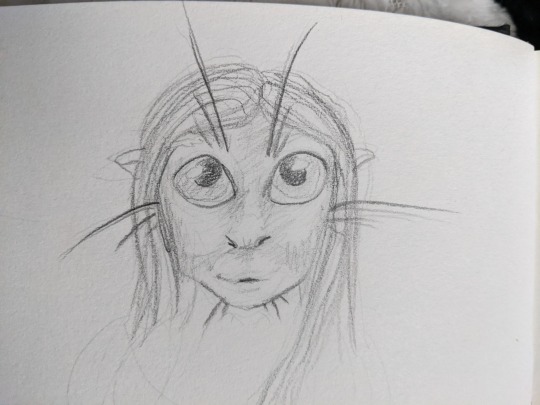
A dwarf woman with whiskers (not the beard kind)
Whiskers are sensory hairs that extend the sense of touch into the space around the animal, and can be sensitive enough to pick up air currents, useful for navigating underground warrens. Smell, touch and even taste are enough for human geologists to identify most minerals, so it's reasonable to expect dwarves to know what they are digging through even if they can't see it.
#Dwarf Fortress#Dorf Fort#df#Strike The Earth#dwarf#dwarffortress#marsupial dwarves#speculative biology#my art
103 notes
·
View notes
Text
important world-building question: do dwarves or elves make more sense as marsupials
#this is not the bl setting just to be clear#...though it would explain why there's no half-dwarves in vanilla dnd
11 notes
·
View notes
Text
History Nerd Stuff
Man I’ve been reading “Sapiens: A Brief History of Humankind” which let me tell you is a goddamn BALLER of a time. And like, I’ve been into tracing the effects of the agricultural revolution since my Derrick Jensen kick in high school but this is the first time I’ve seen someone tie that in with the Cognitive revolution? And I legit had no idea that at one point, there were six genuinely different species of hominins (human-like species) co-existing before the Curtain of Silence(pre-history)???
And the author is like ‘yeah dude we just don’t know shit about how all that went down. I mean, there was probs tons of genocide and clearly some intermarrying because there are traces of Neanderthal (as well as some of the others) in our DNA; and my nerdy Tolkien ass is over here like “WE HAD DWARVES AND ELVES IN THE SPRING TIME OF THE WORLD”. But just hit the part where he’s like ‘whoops yeah you thought we were making shit extinct now. WAIT TIL YOU HEAR ABOUT ALL THE AWESOME MEGAFAUNA WE TOOK DOWN BACK IN THE DAY. THE MARSUPIAL LIONS OF AUSTRALIA. THE CAMELS OF AMERICA. THE DRAGONS OF ANGBAND.
....Now every part of me just wants a sprawling fantasy series with DEEP research and CRAZY speculation that explores world history before the curtain of silence.
#history#sapiens#sapiens a brief history of humankind#Yuval Noah Harari#book#book rec#interesting#non fiction#tolkien#hominins#curtain of silence#cognitive revolution#derrick jensen#dream time
4 notes
·
View notes
Photo

go back to the pasture or you’ll get what’s coming to you
27 notes
·
View notes